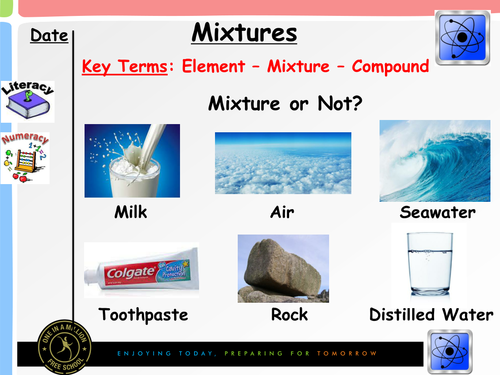

KS3 simple practical lesson involving separating mixtures, with possibility to expand to a more in depth practical activity. Also recaps definitions of Element, Compounds and Mixtures. Equipment Needed – Flour, Sugar, Beakers, Water, Filter Paper, stirring rod or spoon and evaporating dish (Bunsen burner if evaporating in lesson and not left overnight). Additional Information is in the notes section on each slide.
Starter - Picture task for students to identify substances/objects as mixtures or not.
Main 1 - Recap of Element, Compound and Mixture through 5 picture puzzles for students to identify. This is followed by students writing definitions for each, before self assessing against a model answer.
Main 2 - Practical activity. Students use a hint sheet to solve a problem of sugar mixed in with flour. You can substitute a colleagues name into the slide to make it more engaging.
Plenary - Students are given 4 mixture examples (Iron Filings and Flour, Sugar and Water, Rice and Kidney Beans, Sand and Water) along with an equipment list, some needed and some not. They have to identify how they would separate each mixture using only the equipment provided. You could also complete this as a practical activity carousel using the 4 mixtures.
Objectives are below:
GOOD – SEPARATE different substances using different techniques.
GREAT – DESCRIBE particle arrangements in mixtures.
EPIC – EXPLAIN why and how to separate different mixtures using different techniques.
As always any feedback is welcome :)
Starter - Picture task for students to identify substances/objects as mixtures or not.
Main 1 - Recap of Element, Compound and Mixture through 5 picture puzzles for students to identify. This is followed by students writing definitions for each, before self assessing against a model answer.
Main 2 - Practical activity. Students use a hint sheet to solve a problem of sugar mixed in with flour. You can substitute a colleagues name into the slide to make it more engaging.
Plenary - Students are given 4 mixture examples (Iron Filings and Flour, Sugar and Water, Rice and Kidney Beans, Sand and Water) along with an equipment list, some needed and some not. They have to identify how they would separate each mixture using only the equipment provided. You could also complete this as a practical activity carousel using the 4 mixtures.
Objectives are below:
GOOD – SEPARATE different substances using different techniques.
GREAT – DESCRIBE particle arrangements in mixtures.
EPIC – EXPLAIN why and how to separate different mixtures using different techniques.
As always any feedback is welcome :)
Something went wrong, please try again later.
This resource hasn't been reviewed yet
To ensure quality for our reviews, only customers who have purchased this resource can review it
Report this resourceto let us know if it violates our terms and conditions.
Our customer service team will review your report and will be in touch.
£3.00
